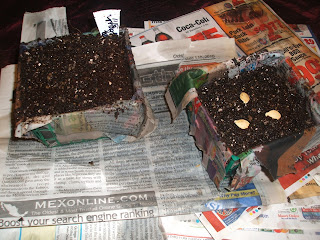My goal with this project is to produce a raised bed, ready for planting, without purchasing anything new, and using as many recyclable/compostable materials as possible. This is not an easy task. It takes a lot to fill even the smallest raised bed. Thats ok. I'm up for the challenge. Especially since I plan on doing a "Lasagna Garden". What's that you ask? Well, for starters, it's a great book of the same name by Patricia Lanza. Ms. Lanza is a wonderful writer and her book containes a wealth of information on how to "Lasagna Garden" as well as a number of usful gardening tips written in a fun and informative fashion. Basically, Lasagna gardening is a method of raised bed gardening that layers brown and green organic materials into "lasagna" type layers that can be directly planted. All of my 9 beds have been started this way and the results have been so successful that now I wouldn't dream of doing my garden beds any other way. The borders of my raised bed will be some great concrete blocks that I received from my dad. The blocks look like something from the 70's and have some interesting "cut outs" that I might be able to use for growing herbs or other small plants.
I placed the blocks on the grass in the general area where I plan to put the bed. It's a good idea to live with something for a few days to see how it works out.
I can't pass up a freebie!
I wonder what the passing motorists thought.
I will be gathering "free" materials for the next few days. I have my work cut out for me. It's not like compostable materials walk up, ring the door bell and exclaim "I home". I have to go looking for them. Kitchen scraps from the restaurant where I work, old cardboard boxes, shredded paper, paratially finished compost, magnolia pods, etc. Wow. I need a lot! It's going to be tough but I'm up for it. I will be topping the raised bed with a few items I have on hand: 1 1/2 bags of potting soil, a bit of vermiculite, some organic fertilizer and a bit of "Marilyn's Own" soil amendment, but thats it for the purchased stuff, and I could get away without some of that if I didn't already have it on hand. See you in a few days when I get my freebies together and build another bed.
It ended up taking 3 days of hunting and gathering but I have a lot of great "stuff". It took a little work but it didn't cost anything, which is always right by me.
I piled everything up for a photo opp (and to have it all within easy reach).
I laid the cardboard out on the grass. I don't bother to remove the lawn. If it's long, I'll mow it, but otherwise just put the cardboard on top and start building.
Be well and happy gardening!






























